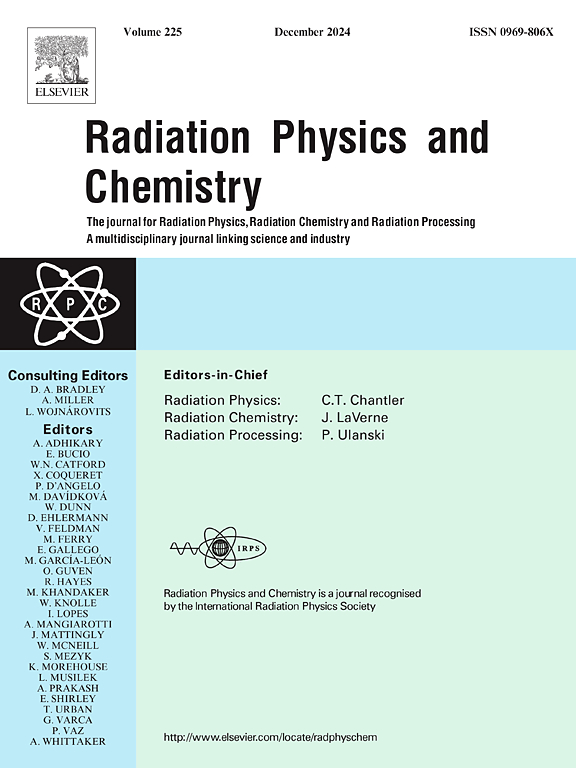Unveiling the effect of CeO2 addition on optical, physical and radiation shielding efficiency in binary lead borate glasses
IF 2.8
3区 物理与天体物理
Q3 CHEMISTRY, PHYSICAL
引用次数: 0
Abstract
Binary systems comprising PbO–B2O3 glasses doped with CeO2 were created using traditional melt-annealing techniques, and the XRD patterns confirmed their amorphous glassy nature. Optical and physical characteristics of some of the glasses were analyzed in relation to the effects of 95 kGy of gamma irradiation. The UV–visible absorption spectra indicated UV peaks below 245 nm associated with the absorption of Fe3+ ions that contaminated the chemicals used, along with two UV peaks at 360 and 440 nm related to Ce3+ and Ce4+ ions, and the potential charge transfer from Ce4+ to Ce3+ through 4f→5d transitions. The optical spectra, as well as both indirect and direct optical energy gap (Eopt) values, demonstrated a high resistance to gamma irradiation. Various physical parameters of the glasses were also determined in relation to the influence of irradiation, such as density (ρ), molar volume (Vm), molar refraction (Rmolar), electronic polarizability (αmolar), refraction loss (Rloss), optical transmission (Toptical), metallization criterion (Mcriterion), static (εstatic) and optical dielectric (εoptical) values, and the refractive index through various calculations. Additionally, experimental, simulated Monte Carlo, and theoretical Phy-X/PSD software were utilized to explore the radiation shielding parameters of the glasses under investigation, including LAC, MAC, Zeff, Neff, Ceff, HVL, TVL, and MFP. The comprehensive results indicate that the produced glasses could serve as promising candidates for practical radiation shielding applications.
揭示了添加CeO2对二元硼酸铅玻璃光学、物理和辐射屏蔽效率的影响
采用传统的熔融退火技术制备了掺杂CeO2的PbO-B2O3玻璃二元体系,XRD谱图证实了其非晶态玻璃的性质。分析了部分玻璃的光学和物理特性与95 kGy辐照效应的关系。紫外-可见吸收光谱表明,245 nm以下的紫外峰与污染化学物质的Fe3+离子的吸收有关,360和440 nm处的两个紫外峰与Ce3+和Ce4+离子有关,Ce4+通过4f→5d跃迁向Ce3+转移电位。光谱以及间接和直接光能隙(Eopt)值均显示出较高的抗γ辐射能力。通过各种计算,确定了辐照影响下玻璃的各种物理参数,如密度(ρ)、摩尔体积(Vm)、摩尔折射率(Rmolar)、电子极化率(αmolar)、折射损耗(Rloss)、光透射率(Toptical)、金属化判据(Mcriterion)、静态(εstatic)和光介电(εoptical)值以及折射率。此外,利用实验、模拟蒙特卡罗和理论物理- x /PSD软件对所研究眼镜的辐射屏蔽参数进行了研究,包括LAC、MAC、Zeff、Neff、Ceff、HVL、TVL和MFP。综合结果表明,所制备的玻璃具有实际的辐射屏蔽应用前景。
本文章由计算机程序翻译,如有差异,请以英文原文为准。
求助全文
约1分钟内获得全文
求助全文
来源期刊

Radiation Physics and Chemistry
化学-核科学技术
CiteScore
5.60
自引率
17.20%
发文量
574
审稿时长
12 weeks
期刊介绍:
Radiation Physics and Chemistry is a multidisciplinary journal that provides a medium for publication of substantial and original papers, reviews, and short communications which focus on research and developments involving ionizing radiation in radiation physics, radiation chemistry and radiation processing.
The journal aims to publish papers with significance to an international audience, containing substantial novelty and scientific impact. The Editors reserve the rights to reject, with or without external review, papers that do not meet these criteria. This could include papers that are very similar to previous publications, only with changed target substrates, employed materials, analyzed sites and experimental methods, report results without presenting new insights and/or hypothesis testing, or do not focus on the radiation effects.
 求助内容:
求助内容: 应助结果提醒方式:
应助结果提醒方式:


